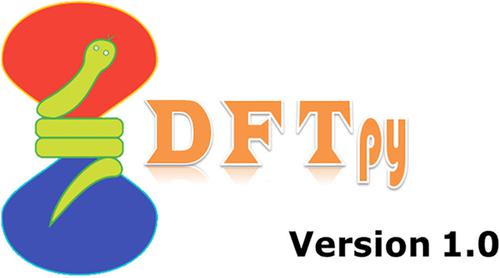当前位置:
X-MOL 学术
›
WIREs Comput. Mol. Sci.
›
论文详情
Our official English website, www.x-mol.net, welcomes your feedback! (Note: you will need to create a separate account there.)
DFTpy: An efficient and object‐oriented platform for orbital‐free DFT simulations
Wiley Interdisciplinary Reviews: Computational Molecular Science ( IF 11.4 ) Pub Date : 2020-06-19 , DOI: 10.1002/wcms.1482 Xuecheng Shao 1 , Kaili Jiang 1 , Wenhui Mi 1 , Alessandro Genova 1, 2 , Michele Pavanello 1, 3
Wiley Interdisciplinary Reviews: Computational Molecular Science ( IF 11.4 ) Pub Date : 2020-06-19 , DOI: 10.1002/wcms.1482 Xuecheng Shao 1 , Kaili Jiang 1 , Wenhui Mi 1 , Alessandro Genova 1, 2 , Michele Pavanello 1, 3
Affiliation

|
In silico materials design is hampered by the computational complexity of Kohn–Sham DFT, which scales cubically with the system size. Owing to the development of new‐generation kinetic energy density functionals (KEDFs), orbital‐free DFT (OFDFT) can now be successfully applied to a large class of semiconductors and such finite systems as quantum dots and metal clusters. In this work, we present DFTpy, an open‐source software implementing OFDFT written entirely in Python 3 and outsourcing the computationally expensive operations to third‐party modules, such as NumPy and SciPy. When fast simulations are in order, DFTpy exploits the fast Fourier transforms from PyFFTW. New‐generation, nonlocal and density‐dependent‐kernel KEDFs are made computationally efficient by employing linear splines and other methods for fast kernel builds. We showcase DFTpy by solving for the electronic structure of a million‐atom system of aluminum metal which was computed on a single CPU. The Python 3 implementation is object‐oriented, opening the door to easy implementation of new features. As an example, we present a time‐dependent OFDFT implementation (hydrodynamic DFT) which we use to compute the spectra of small metal clusters recovering qualitatively the time‐dependent Kohn–Sham DFT result. The Python codebase allows for easy implementation of application programming interfaces. We showcase the combination of DFTpy and ASE for molecular dynamics simulations of liquid metals. DFTpy is released under the MIT license.
中文翻译:

DFTpy:高效的面向对象的平台,用于无轨道DFT仿真
在计算机材料设计中,Kohn-Sham DFT的计算复杂度受到阻碍,该计算复杂度随系统大小而按比例缩放。由于新一代动能密度函数(KEDF)的发展,无轨道DFT(OFDFT)现在可以成功地应用于一大类半导体以及诸如量子点和金属簇的有限系统。在这项工作中,我们介绍DFTpy,这是一个完全用Python 3编写的实现OFDFT的开源软件,并将计算量大的操作外包给第三方模块(例如NumPy和SciPy)。当需要进行快速仿真时,DFTpy将利用PyFFTW的快速傅立叶变换。通过使用线性样条和其他方法进行快速内核构建,新一代,非本地和依赖密度的内核KEDF的计算效率更高。通过解决在单个CPU上计算的百万原子铝金属系统的电子结构,我们展示了DFTpy。Python 3实现是面向对象的,这为轻松实现新功能打开了大门。例如,我们介绍了一个与时间有关的OFDFT实现(流体动力学DFT),我们用它来计算小金属团簇的光谱,从而定性地恢复与时间有关的Kohn-Sham DFT结果。Python代码库可轻松实现应用程序编程接口。我们展示了DFTpy和ASE的结合,用于液态金属的分子动力学模拟。DFTpy是根据MIT许可发布的。为轻松实施新功能打开了大门。例如,我们介绍了一个与时间有关的OFDFT实现(流体动力学DFT),我们用它来计算小金属团簇的光谱,从而定性地恢复与时间有关的Kohn-Sham DFT结果。Python代码库可轻松实现应用程序编程接口。我们展示了DFTpy和ASE的结合,用于液态金属的分子动力学模拟。DFTpy是根据MIT许可发布的。为轻松实施新功能打开了大门。例如,我们介绍了一个与时间有关的OFDFT实现(流体动力学DFT),我们用它来计算小金属团簇的光谱,从而定性地恢复与时间有关的Kohn-Sham DFT结果。Python代码库可轻松实现应用程序编程接口。我们展示了DFTpy和ASE的结合,用于液态金属的分子动力学模拟。DFTpy是根据MIT许可发布的。我们展示了DFTpy和ASE的结合,用于液态金属的分子动力学模拟。DFTpy是根据MIT许可发布的。我们展示了DFTpy和ASE的结合,用于液态金属的分子动力学模拟。DFTpy是根据MIT许可发布的。
更新日期:2020-06-19
中文翻译:

DFTpy:高效的面向对象的平台,用于无轨道DFT仿真
在计算机材料设计中,Kohn-Sham DFT的计算复杂度受到阻碍,该计算复杂度随系统大小而按比例缩放。由于新一代动能密度函数(KEDF)的发展,无轨道DFT(OFDFT)现在可以成功地应用于一大类半导体以及诸如量子点和金属簇的有限系统。在这项工作中,我们介绍DFTpy,这是一个完全用Python 3编写的实现OFDFT的开源软件,并将计算量大的操作外包给第三方模块(例如NumPy和SciPy)。当需要进行快速仿真时,DFTpy将利用PyFFTW的快速傅立叶变换。通过使用线性样条和其他方法进行快速内核构建,新一代,非本地和依赖密度的内核KEDF的计算效率更高。通过解决在单个CPU上计算的百万原子铝金属系统的电子结构,我们展示了DFTpy。Python 3实现是面向对象的,这为轻松实现新功能打开了大门。例如,我们介绍了一个与时间有关的OFDFT实现(流体动力学DFT),我们用它来计算小金属团簇的光谱,从而定性地恢复与时间有关的Kohn-Sham DFT结果。Python代码库可轻松实现应用程序编程接口。我们展示了DFTpy和ASE的结合,用于液态金属的分子动力学模拟。DFTpy是根据MIT许可发布的。为轻松实施新功能打开了大门。例如,我们介绍了一个与时间有关的OFDFT实现(流体动力学DFT),我们用它来计算小金属团簇的光谱,从而定性地恢复与时间有关的Kohn-Sham DFT结果。Python代码库可轻松实现应用程序编程接口。我们展示了DFTpy和ASE的结合,用于液态金属的分子动力学模拟。DFTpy是根据MIT许可发布的。为轻松实施新功能打开了大门。例如,我们介绍了一个与时间有关的OFDFT实现(流体动力学DFT),我们用它来计算小金属团簇的光谱,从而定性地恢复与时间有关的Kohn-Sham DFT结果。Python代码库可轻松实现应用程序编程接口。我们展示了DFTpy和ASE的结合,用于液态金属的分子动力学模拟。DFTpy是根据MIT许可发布的。我们展示了DFTpy和ASE的结合,用于液态金属的分子动力学模拟。DFTpy是根据MIT许可发布的。我们展示了DFTpy和ASE的结合,用于液态金属的分子动力学模拟。DFTpy是根据MIT许可发布的。


























 京公网安备 11010802027423号
京公网安备 11010802027423号